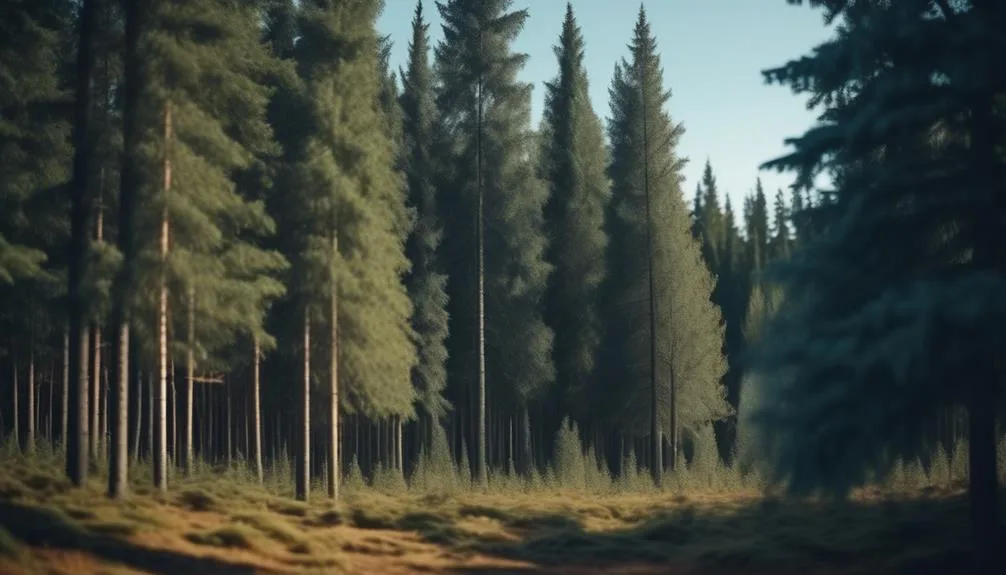Spruce trees grow in North America, Europe, and Asia, each with its own unique habitat and environmental needs. From the forests of the Pacific Northwest to the mountain slopes of the Alps and the taiga of Siberia, spruce trees thrive in various landscapes.
Understanding the diverse habitats and factors contributing to their growth and survival is an intriguing topic worth exploring.
North American Spruce Habitats
In North America, spruce trees thrive in diverse habitats ranging from the coastal forests of the Pacific Northwest to the subalpine regions of the Rocky Mountains, demonstrating their adaptability to a wide range of environmental conditions.
These resilient trees are particularly abundant in the Canadian boreal and Alaskan taiga regions, where they play a crucial role in shaping the landscape and providing habitats for numerous species.
The Canadian boreal forest, stretching across the northern part of the continent, is home to vast expanses of spruce trees, creating a unique ecosystem that supports diverse wildlife.
Similarly, the Alaskan taiga, characterized by its cold climate and coniferous forests, offers a prime environment for spruce trees to flourish.
Their presence in these regions not only contributes to the beauty of the landscape but also sustains the delicate balance of these ecosystems.
European Spruce Environments
European Spruce Environments, similar to their North American counterparts, offer a diverse range of habitats for these resilient trees, supporting unique ecosystems and wildlife.
- Soil conditions: European spruce trees thrive in well-drained, acidic soils, particularly in areas with a mix of sand, silt, and clay.
- Climate variation: These trees are adaptable to a variety of climates, from the cold, subarctic conditions of Scandinavia to the milder, temperate climates of Central Europe.
- Ecosystem diversity: Spruce forests in Europe are integral parts of diverse ecosystems, interacting with a variety of plant and animal species.
- Wildlife interaction: European spruce forests are vital habitats for a range of wildlife, including deer, birds, and insects, contributing to the overall biodiversity of the region.
European Spruce Environments provide a rich tapestry of habitats, showcasing the adaptability and significance of these trees within the European landscape.
Asian Spruce Tree Locations
Nestled amidst the diverse landscapes of Asia, the spruce trees find their home in a wide range of habitats, from the mountainous regions of the Himalayas to the temperate forests of Japan.
Japanese spruce forests, with their enchanting allure, are primarily located in the central and northern parts of the country, thriving in the cool, humid climate. These forests not only provide habitat for diverse wildlife but also create stunning vistas that attract nature enthusiasts from around the world.
In China, the spruce ecosystems are mainly found in the higher elevations of the country, particularly in the mountainous areas of the southwest. These ecosystems play a vital role in maintaining the ecological balance and are essential for the conservation of biodiversity in the region. The Chinese spruce forests, with their majestic beauty, are a testament to the resilience and adaptability of these remarkable trees.
Spruce Trees in Mountainous Regions
Amidst the rugged peaks and sweeping valleys, spruce trees thrive in the challenging yet breathtaking mountainous regions, showcasing their resilience and adaptability in the face of nature's grandeur. These areas are characterized by unique ecosystems, including alpine spruce ecosystems and subalpine spruce forests.
Here's what you should know about spruce trees in mountainous regions:
- Adaptability: Spruce trees have adapted to survive in harsh mountain environments, with the ability to withstand strong winds and heavy snowfall.
- Biodiversity: Mountainous regions host a diverse range of spruce species, contributing to the rich biodiversity of these areas.
- Erosion Control: The extensive root systems of spruce trees help prevent soil erosion in the steep terrain of mountainous regions.
- Water Regulation: Spruce trees play a crucial role in regulating water flow in mountain ecosystems, impacting the overall hydrological cycle.
Diverse Habitats of Spruce Trees
Thriving in various ecosystems, spruce trees exhibit remarkable adaptability and contribute significantly to the diverse habitats they inhabit, including mountainous regions and beyond. Their ability to thrive in different environments makes them a crucial component of various ecosystems.
Spruce trees are known for their adaptability to cold climates, making them prevalent in boreal forests, where they play a vital role in shaping the landscape and providing habitats for numerous species. Additionally, they can also be found in temperate rainforests, where their dense canopies provide shelter for a wide array of wildlife.
Conservation efforts are crucial to maintaining the diverse habitats of spruce trees, as they're often impacted by deforestation and climate change. Protecting these habitats is essential for preserving the rich biodiversity that depends on spruce trees for survival.
Conclusion
In every corner of the globe, spruce trees stand as resilient symbols of natural beauty and adaptability. From North America to Asia, they thrive in diverse environments, enriching the world's landscapes with their majestic presence.
Keep an eye out for these impressive evergreens on your next outdoor adventure and ponder the profound ways they shape our planet's natural tapestry.

My interest in trees started when I first saw the giant sequoias in Yosemite.
I was a teenager then, and I remember thinking, “I need to learn more about this.”
That moment stuck with me.
A few years later, I went on to study forestry at Michigan Tech.
Since graduating, I’ve worked in a mix of hands-on tree care and community education.
I’ve spent over ten years helping people understand how to plant, maintain, and protect the trees in their neighborhoods.
I don’t see trees as just part of the landscape.
They are living things that make a real difference in our daily lives.
